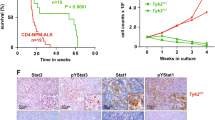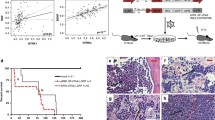Abstract
The mechanisms of cell transformation mediated by the highly oncogenic, chimeric NPM/ALK tyrosine kinase remain only partially understood. Here we report that cell lines and native tissues derived from the NPM/ALK-expressing T-cell lymphoma (ALK+ TCL) display phosphorylation of the extracellular signal-regulated protein kinase (ERK) 1/2 complex. Transfection of BaF3 cells with NPM/ALK induces phosphorylation of EKR1/2 and of its direct activator mitogen-induced extracellular kinase (MEK) 1/2. Depletion of NPM/ALK by small interfering RNA (siRNA) or its inhibition by WHI-154 abrogates the MEK1/2 and ERK1/2 phosphorylation. The NPM/ALK-induced MEK/ERK activation is independent of c-Raf as evidenced by the lack of MEK1/2 and ERK1/2 phosphorylation upon c-Raf inactivation by two different inhibitors, RI and ZM336372, and by its siRNA-mediated depletion. In contrast, ERK1/2 activation is strictly MEK1/2 dependent as shown by suppression of the ERK1/2 phosphorylation by the MEK1/2 inhibitor U0126. The U0126-mediated inhibition of ERK1/2 activation impaired proliferation and viability of the ALK+ TCL cells and expression of antiapoptotic factor Bcl-xL and cell cycle-promoting CDK4 and phospho-RB. Finally, siRNA-mediated depletion of both ERK1 and ERK2 inhibited cell proliferation, whereas depletion of ERK 1 (but not ERK2) markedly increased cell apoptosis. These findings identify MEK/ERK as a new signaling pathway activated by NPM/ALK and indicate that the pathway represents a novel therapeutic target in the ALK-induced malignancies.






Similar content being viewed by others
References
Bischof D, Pulford K, Mason DY, Morris SW . (1997). Role of the nucleophosmin (NPM) portion of the non-Hodgkin's lymphoma-associated NPM-anaplastic lymphoma kinase fusion protein in oncogenesis. Mol Cell Biol 17: 2312–2325.
Chiarle R, Gong JZ, Guasparri I, Pesci A, Cai J, Liu J et al. (2003). NPM-ALK transgenic mice spontaneously develop T-cell lymphomas and plasma cell tumors. Blood 101: 1919–1927.
Chiarle R, Simmons WJ, Cai H, Dhall G, Zamo A, Raz R et al. (2005). Stat3 is required for ALK-mediated lymphomagenesis and provides a possible therapeutic target. Nat Med 11: 623–629.
Crockett DK, Lin Z, Elenitoba-Johnson KS, Lim MS . (2004). Identification of NPM–ALK interacting proteins by tandem mass spectrometry. Oncogene 23: 2617–2629.
Epling-Burnette PK, Bai F, Wei S, Chaurasia P, Painter JS, Olashaw N et al. (2004). ERK couples chronic survival of NK cells to constitutively activated Ras in lymphoproliferative disease of granular lymphocytes (LDGL). Oncogene 23: 9220–9229.
Fujimoto J, Shiota M, Iwahara T, Seki N, Satoh H, Mori S et al. (1996). Characterization of the transforming activity of p80, a hyperphosphorylated protein in a Ki-1 lymphoma cell line with chromosomal translocation t(2;5). Proc Natl Acad Sci USA 93: 4181–4186.
Hallek M, Bergsagel PL, Anderson KC . (1998). Multiple myeloma: increasing evidence for a multistep transformation process. Blood 91: 3–21.
Hanahan D, Weinberg RA . (2000). The hallmarks of cancer. Cell 100: 57–70.
Hoshino R, Chatani Y, Yamori T, Tsuruo T, Oka H, Yoshida O et al. (1999). Constitutive activation of the 41-/43-kDa mitogen-activated protein kinase signaling pathway in human tumors. Oncogene 18: 813–822.
Hoyle PE, Moye PW, Steelman LS, Blalock WL, Franklin RA, Pearce M et al. (2000). Differential abilities of the Raf family of protein kinases to abrogate cytokine dependency and prevent apoptosis in murine hematopoietic cells by a MEK1-dependent mechanism. Leukemia 14: 642–656.
Kim SC, Hahn JS, Min YH, Yoo NC, Ko YW, Lee WJ . (1999). Constitutive activation of extracellular signal-regulated kinase in human acute leukemias: combined role of activation of MEK, hyperexpression of extracellular signal-regulated kinase, and downregulation of a phosphatase, PAC1. Blood 93: 3893–3899.
Kuefer MU, Look AT, Pulford K, Behm FG, Pattengale PK, Mason DY et al. (1997). Retrovirus-mediated gene transfer of NPM-ALK causes lymphoid malignancy in mice. Blood 90: 2901–2910.
Marzec M, Kasprzycka M, Ptasznik A, Wlodarski P, Zhang Q, Odum N et al. (2005). Inhibition of ALK enzymatic activity in T-cell lymphoma cells induces apoptosis and suppresses proliferation and STAT3 phosphorylation independently of Jak3. Lab Invest 85: 1544–1554.
Matsumoto S, Miyagishi M, Akashi H, Nagai R, Taira K . (2005). Analysis of double-stranded RNA-induced apoptosis pathways using interferon-response noninducible small interfering RNA expression vector library. Biol Chem 280: 25687–25696.
Milella M, Kornblau SM, Estrov Z, Carter BZ, Lapillonne H, Harris D et al. (2001). Therapeutic targeting of the MEK/MAPK signal transduction module in acute myeloid leukemia. J Clin Invest 108: 851–859.
Morgan MA, Dolp O, Reuter CW . (2001). Cell-cycle-dependent activation of mitogen-activated protein kinase kinase (MEK-1/2) in myeloid leukemia cell lines and induction of growth inhibition and apoptosis by inhibitors of RAS signaling. Blood 97: 1823–1834.
Morris SW, Kirstein MN, Valentine MB, Dittmer KG, Shapiro DN, Saltman DL et al. (1994). Fusion of a kinase gene, ALK, to a nucleolar protein gene, NPM, in non-Hodgkin's lymphoma. Science 263: 1281–1284.
Motegi A, Fujimoto J, Kotani M, Sakuraba H, Yamamoto T . (2004). ALK receptor tyrosine kinase promotes cell growth and neurite outgrowth. J Cell Sci 117: 3319–3329.
Pardo OE, Arcaro A, Salerno G, Raguz S, Downward J, Seckl MJ . (2002). Fibroblast growth factor-2 induces translational regulation of Bcl-XL and Bcl-2 via a MEK-dependent pathway: correlation with resistance to etoposide-induced apoptosis. J Biol Chem 277: 12040–12046.
Platanias LC . (2003). Map kinase signaling pathways and hematologic malignancies. Blood 101: 4667–4679.
Pratt G . (2002). Molecular aspects of multiple myeloma. Mol Pathol 55: 273–283.
Roux PP, Blenis J . (2004). ERK and p38 MAPK-activated protein kinases: a family of protein kinases with diverse biological functions. Microbiol Mol Biol Rev 68: 320–344.
Shiota M, Fujimoto J, Semba T, Satoh H, Yamamoto T, Mori S . (1994). Hyperphosphorylation of a novel 80 kDa protein-tyrosine kinase similar to Ltk in a human Ki-1 lymphoma cell line, AMS3. Oncogene 9: 1567–1574.
Souttou B, Carvalho NB, Raulais D, Vigny M . (2001). Activation of anaplastic lymphoma kinase receptor tyrosine kinase induces neuronal differentiation through the mitogen-activated protein kinase pathway. J Biol Chem 276: 9526–9531.
Tanaka T, Kyrokawa M, Ueki K, Tanaka K, Imai Y, Mitani K et al. (1996). The extracellular signal-regulated kinase pathway phosphorylates AML1, an acute myeloid leukemia gene product, and potentially regulates its transactivation ability. Mol Cell Biol 16: 3967–3979.
Towatari M, Iida H, Tanimoto M, Iwata H, Hamaguchi M, Saito H . (1997). Constitutive activation of mitogen-activated protein kinase pathway in acute leukemia cells. Leukemia 11: 479–484.
Ueda Y, Hirai S, Osada S, Suzuki A, Mizuno K, Ohno S . (1996). Protein kinase C activates the MEK–ERK pathway in a manner independent of Ras and dependent on Raf. J Biol Chem 271: 23512–23519.
Ussar S, Voss T . (2004). MEK1 and MEK2, different regulators of the G1/S transition. J Biol Chem 279: 43861–43869.
Wan W, Albom MS, Lu L, Quail MR, Becknell NC, Weinberg LR et al. (2006). Anaplastic lymphoma kinase activity is essential for the proliferation and survival of anaplastic large-cell lymphoma cells. Blood 107: 1617–1623.
Wang X, Wang Q, Hu W, Evers BM . (2004). Regulation of phorbol ester-mediated TRAF1 induction in human colon cancer cells through a PKC/RAF/ERK/NF-kappaB-dependent pathway. Oncogene 23: 1885–1895.
Wasik MA . (2002). Expression of anaplastic lymphoma kinase in non-Hodgkin's lymphomas and other malignant neoplasms. Biological, diagnostic, and clinical implications. Am J Clin Pathol 118: S81–S92.
Wen-Sheng W . (2006). Protein kinase C alpha trigger Ras and Raf-independent MEK/ERK activation for TPA-induced growth inhibition of human hepatoma cell HepG2. Cancer Lett 239: 27–35.
Wlodarski P, Kasprzycka M, Liu X, Marzec M, Robertson ES, Slupianek A et al. (2005). Activation of mammalian target of rapamycin in transformed B lymphocytes is nutrient dependent but independent of Akt, mitogen-activated protein kinase/extracellular signal-regulated kinase kinase, insulin growth factor-I, and serum. Cancer Res 65: 7800–7808.
Zhang Q, Raghunath PN, Xue L, Majewski M, Carpentieri DF, Odum N et al. (2002). Multilevel dysregulation of STAT3 activation in anaplastic lymphoma kinase-positive T/null-cell lymphoma. J Immunol 168: 466–474.
Acknowledgements
This work was supported in part by grants from the National Cancer Institute – R01-CA89194 and R01-CA96856.
Author information
Authors and Affiliations
Corresponding author
Rights and permissions
About this article
Cite this article
Marzec, M., Kasprzycka, M., Liu, X. et al. Oncogenic tyrosine kinase NPM/ALK induces activation of the MEK/ERK signaling pathway independently of c-Raf. Oncogene 26, 813–821 (2007). https://doi.org/10.1038/sj.onc.1209843
Received:
Revised:
Accepted:
Published:
Issue Date:
DOI: https://doi.org/10.1038/sj.onc.1209843
- Springer Nature Limited
Keywords
This article is cited by
-
The mechanism of cancer drug addiction in ALK-positive T-Cell lymphoma
Oncogene (2020)
-
Peripheral T cell lymphomas: from the bench to the clinic
Nature Reviews Cancer (2020)
-
Exploring Missense Mutations in Tyrosine Kinases Implicated with Neurodegeneration
Molecular Neurobiology (2017)
-
Activating mutations in ALK kinase domain confer resistance to structurally unrelated ALK inhibitors in NPM-ALK-positive anaplastic large-cell lymphoma
Journal of Cancer Research and Clinical Oncology (2014)
-
Differential expression of aurora-A kinase in T-cell lymphomas
Modern Pathology (2013)




